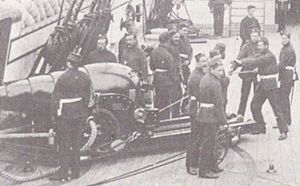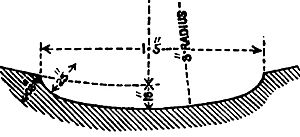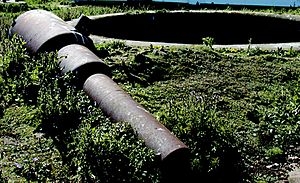RML 7-inch gun facts for kids
Quick facts for kids RML 7-inch gun |
|
|---|---|

7-inch 6½ ton Mk I gun and crew on HMS Minotaur
|
|
| Type | Naval gun Coast defence gun |
| Place of origin | United Kingdom |
| Service history | |
| Used by | Royal Navy |
| Production history | |
| Designer | Royal Gun Factory |
| Designed | 1865 (7 & 6½ ton) 1874 (90 cwt) |
| Manufacturer | Royal Arsenal |
| Unit cost | £425 |
| Variants | 7 ton Mks I – IV 6½ ton Mks I – III 90 cwt |
| Specifications | |
| Barrel length | 7 ton : 126 inches (3,200 mm) 6½ ton & 90 cwt : 111 inches (2,800 mm) |
|
|
|
| Shell | 112 to 115 pounds (51 to 52 kg) Palliser, Common, Shrapnel 160 pounds (73 kg) double common shell |
| Calibre | 7-inch (177.8 mm) |
| Muzzle velocity | 7 ton : 1,561 feet per second (476 m/s) 6½ ton : 1,525 feet per second (465 m/s) 90 cwt : 1,325 feet per second (404 m/s) |
| Maximum firing range | 5,500 yards (5,000 m) |
The RML 7-inch guns were powerful cannons used by the British Navy in the late 1800s. These guns were loaded from the front (muzzle-loading) and had special grooves inside (rifling) to make their shots fly straighter. They were used on many ships and also on land to protect the coast.
Contents
How the RML 7-inch Gun Was Designed

These guns were special because they used a new way of making the inside of the barrel, called "Woolwich" rifling. Rifling means adding spiral grooves inside the gun barrel. This makes the projectile spin as it leaves the gun, like a football thrown with a spiral. Spinning makes the shot fly much more accurately.
The Woolwich system was an improved version of an older French design. It used 3 to 9 wide, shallow grooves. This new system was adopted in May 1865.
All versions of these guns were built in a similar way. They had a strong steel tube in the middle. Around this tube, there were layers of wrought-iron coils. These coils made the gun very strong and able to handle the force of firing. The rifling always had 3 grooves that twisted one full turn every 245 inches.
The way these guns were built changed over time. The first models (Mk I) used many thin coils, which was expensive. Later models, like the Mk III, used a simpler and cheaper design.
The 7-ton RML Gun

The 7-ton version of the RML 7-inch gun was first used in 1865. It was mainly a coast defence gun. This means it was placed on land to protect important areas from enemy ships. It replaced an earlier gun that didn't work as well. Three different versions (Marks) of this 7-ton gun were made.
The 6½-ton RML Gun
This version was introduced in 1865 and was mostly used on ships. It was designed to be a "broadside" or "pivot" gun for frigates. Broadside guns were mounted on the sides of the ship, while pivot guns could turn more freely. This gun replaced older, less effective naval guns.
It was very popular, with 331 of them being made. This gun was 18 inches shorter than the 7-ton land version. This shorter length made it easier to use on ships. Some reports say these guns could shoot through armor up to 7.7 inches thick!
Many famous warships used this gun, including:
- Amazon-class sloops (from 1865)
- HMS Bellerophon (from 1866)
- HMS Vixen (from 1866)
- HMS Viper (from 1866)
- Minotaur-class ironclads (from 1867)
- Eclipse-class sloops (from 1867)
- Defence-class ironclads (re-armed in 1867)
- HMS Enterprise & HMS Research (re-armed in 1868)
- Warrior-class ironclads (re-armed in 1867–1868)
- Hector-class ironclads (from 1868)
- HMS Achilles (re-armed in 1868)
- HMS Inconstant (from 1869)
- HMS Shah (from 1876)
- Briton-class screw corvettes (from 1871)
The 90 cwt RML Gun
This was a lighter version of the 7-inch gun, weighing about 4½ tons (90 cwt). It was introduced in 1874. This gun was not as powerful as the other 7-inch guns. It was used on ships that didn't have armor, and it wasn't meant to attack armored enemy ships.
Some of the first 90 cwt guns were made by taking existing 6½-ton guns and making them lighter. This was possible because the 90 cwt guns used smaller explosive charges, which put less stress on the gun. New guns were also built following this lighter design.
Some of the warships that carried this gun include:
- Osprey-class sloops (from 1874)
- HMS Raleigh (from 1874)
- Fantome-class sloops (from 1874)
- Bacchante-class corvettes (from 1877)
- Condor-class gunvessels (from 1877)
Ammunition Used by the Guns
The RML 7-inch guns could fire different types of ammunition depending on the target.
For attacking armored warships, the main type of ammunition was Palliser shot or shell. These were fired with a very strong "battering" charge. This charge made the projectile fly as fast as possible to hit hard targets.
All the guns also used other types of ammunition:
- Shrapnel shells: These shells were filled with many small balls and a bursting charge. They were used to attack groups of enemy soldiers.
- Explosive common shells: These shells were filled with gunpowder and exploded on impact. They were used against ships that didn't have armor.
- "Double" common shell: This was a much longer version of the common shell. It held about twice as much gunpowder. It was not very accurate beyond 2,000 yards. However, it was useful for attacking wooden warships at closer distances.
These 7-inch RML guns were unique because they were the only heavy RML guns that did not use gas-checks. Gas-checks were special parts used in other heavy guns to prevent gas from escaping past the projectile when fired.
Where to See Surviving RML 7-inch Guns
You can still find examples of these historic guns in different places around the world:
- Two 6½-ton Mk I guns (Numbers 148 & 163) have been restored. You can see them at Garden Island Rockingham, Western Australia (Fleet Base West).
- Several 6½-ton Mk I guns are located on Ascension Island.
- A 6½-ton Mk I gun is at Fort Siloso, Sentosa, Singapore.
- A 6½-ton Mk III gun from 1869 is at Elizabeth Castle, Jersey, UK.
- The remains of several 7-ton Mk III guns can be found on Flat Holm island, UK.
- Nine 7-ton Mk III guns are on Steep Holm island, UK.
- A 7-ton Mk I gun is displayed at The Citadel, Nova Scotia, Canada.
- A 6½-ton Mk I gun is located on Signal Hill (Cape Town), South Africa.
See also
- List of naval guns








